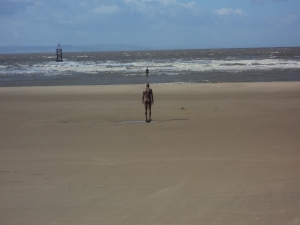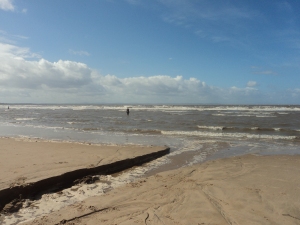I was determined to make a significant detour during August to see some public sculpture on Crosby beach and this short piece gives me an opportunity to show off some of my photographs. The journey to Liverpool was not in vain and I was able to glimpse again at first hand the sheer genius of Gormley as a sculptor and public artist.
Another place consists (I believe 60) cast iron sculptures of the artist’s own body, facing towards the sea. The original proposal was for the Wattenmeer, Cuxhaven, Germany in 1995 and here is the brief:
“To install a hundred solid cast iron bodyforms along the coast to the west and south of the Kugelbake. The work will occupy an area of 1.75 square kilometres, with the pieces placed between 50 and 250 metres apart along the tideline and one kilometre out towards the horizon, to which they will all be facing. Depending on the fall of the land, the state of the tide, the weather conditions and the time of day the work will be more or less visible. The sculptures will be installed on a level plane attached to 2 metre vertical steel piles. The ones closest to the horizon will stand on the sand, those nearer the shore being progressively buried. At high water, the sculptures that are completely visible when the tide is out will be standing up to their necks in water.”
The cast iron body forms were displayed at several locations in Europe but now have found a permanent home here at Crosby beach . the proposal to do so was controversial but Sefton Council in 2007 made a bold and imaginative decision that would allow the sculptures to be kept permanently at Crosby Beach in place of being moved to New York.
Lt’s look at some of these sculptures more closely
The sculptures are made from 17 body-casts taken from Gormley’s body. The sculptures are all standing in a similar way, with the lungs more or less inflated and their postures carrying different degrees of tension or relaxation. The installation stretched 2.5 kilometres down the coast and 1 kilometre out to sea, with an average distance between the pieces of 500 metres. They were all on a level and those closest to the shore were buried as far as their knees.
The idea was to test time and tide, stillness and movement, and somehow engage with the daily life of the beach. This was no exercise in romantic escapism. The figures themselves have a deep sense of serenity and thoughtfulness as they stare out in the same direction – there is a kind of deep connectedness and attentiveness . Contemplation, attention and focus were the words that came most immediately to mind as I wandered up and down the beach. The tide was moving swiftly in and so it was fascinating to see some of the statues being immersed in water .
Gormley remains a master of public art and I was quite extraordinarily moved by the way in which this art evokes such a powerful sense both life and death ; of nature claiming its extraordinary claim on humanity and sometimes our powerlessness over the forces of nature and perhaps even life itself? It is however this stillness and contemplation that I think is the radical voice of this work.
























